Technics EAH-AZ80
MSRP $300.00
“Great sound and comfort for hours of hi-fi listening.”
Pros
- Really comfortable
- Warm, detailed sound
- Top-notch noise cancellation
- Class-leading call quality
- Convenient 3-way Bluetooth
Cons
- A bit pricey
- Slightly lacking in clarity
Technics might not be the first brand you think of when it comes to premium noise-canceling wireless earbuds. But the company’s latest flagship — the EAH-AZ80 — deserve serious attention if you’re busy sizing up your options from the usual suspects. They’re comfy, they sound great, and if you’re a serious multitasker, you’re going to love their unique three-way Bluetooth connection. At $300, they’re right in the middle of the premium pack — pricier than Apple, Sony, and Sennheiser, yet more affordable than Bowers & Wilkins, Master & Dynamic, and Bang & Olufsen.
Does that make them the Goldilocks pick of the bunch? I think it does.
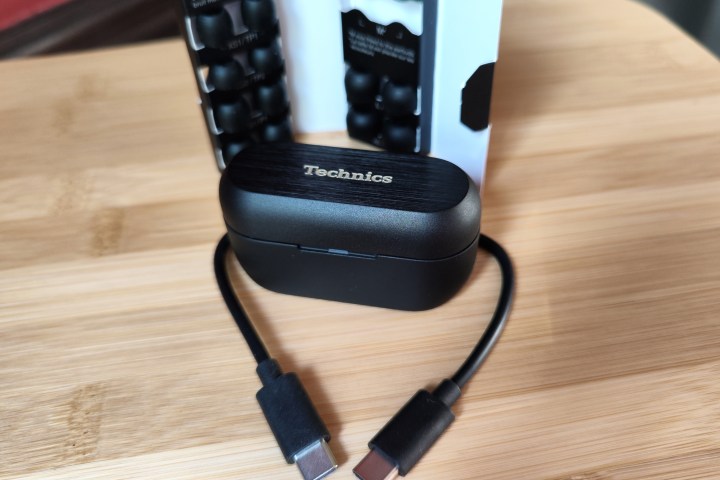
It can be tempting to look at a set of earbuds and judge their potential comfort and fit by their overall dimensions. To some extent, this isn’t a bad rule of thumb — Apple’s second-gen AirPods Pro are very small and they happen to be very comfortable. But size isn’t everything. What can matter more is the shape. The EAH-AZ80 — I’ll call them the AZ80 from here on in — may be a bit big and bulbous, however, the portion that sits in your concha is carved into a smaller, ergonomic profile.
For me, that shape feels like it was custom designed for my ears. I’ve been able to wear them for several hours at a stretch and not only are they more comfortable than the first-gen Technics EAH-AZ60, but they’re also considerably more comfortable than the Sony WF-1000XM4 and the Bowers & Wilkins Pi7 S2.
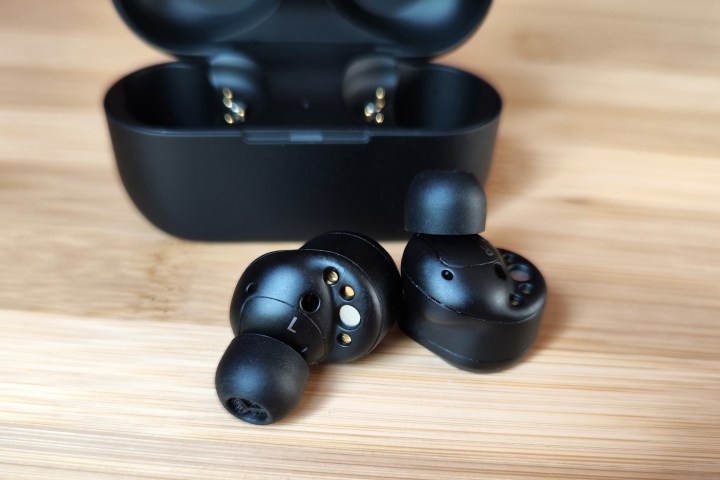
Granted, everyone’s ears are different. But with seven different sizes and shapes of silicone eartips (including the preinstalled mediums), there’s a good chance that most folks will find a fit that works unless you’ve had serious problems with earbuds in the past. Once you’ve found a comfy, secure fit, the AZ80’s IPX4 rating means you can take them to the gym or on a run, and that sweat shouldn’t be a problem as long as you wipe them off afterward.
Technics also deserves credit for designing the AZ80’s charging case in such a way that the bulk of the earbuds sits proud of their sockets, giving you lots of room to grip their contours with your fingers. And yet, the case itself is one of the smallest in this category; only the AirPods Pro have a slimmer profile. This might seem like a small thing and yet, when you reach for a device multiple times every day, not needing to fumble with them can make a big difference to your enjoyment. You get wireless charging which is not necessarily a given (ahem, Bose QuietComfort Earbuds II and Master & Dynamic MW08). However, if you decide to charge the case using the included cable, be warned: Technics has opted for a USB-C-to-USB-C version with no USB-A adapter, which could be a wee bit of a problem for those with older laptops.

Another feature that’s going to make perpetual device switchers happy is the AZ80’s ability to maintain simultaneous Bluetooth connections with up to three different devices. It’s a feature they share with their $250 siblings, the EAH-AZ60M2, but it’s otherwise entirely unique in the wireless earbud world. Standard Bluetooth Multipoint gives you two device connections, but the AZ80 happily connects you to three of them and I found it worked just as well as standard Multipoint. With a MacBook Air, an iPhone 14, and a Xiaomi 12 Pro as my test subjects, I was able to start and stop media playback on each device and the AZ80 always let me hear the one that was currently playing.
Keeping this three-way line of communication open comes at the cost of LDAC codec support, but I’m guessing that anyone who needs the convenience of multi-device connectivity will be willing to sacrifice a small amount of enhanced audio quality. More on that in a moment.
I’ve always been impressed by Technics’ active noise cancellation (ANC) — it’s right up there with Sony and Apple — and the AZ80 have kept pace. They perform very closely to Bose QuietComfort II, AirPods Pro 2, and Sony WF-1000XM4 in the situations I tried like noisy streets, crowded cafes, and my annoyingly loud bathroom fan. I didn’t get a chance to try them while flying, but my guess is they’ll handle jet engine noise with ease. One area where they proved especially capable was in dealing with wind noise, which was completely suppressed.

Both the ANC and transparency modes are configurable in the Technics Audio Connect app (iOS/Android). I tend to be an all-or-nothing person when it comes to these modes — I either want to hear everything with perfect clarity or I want it to all go away — so my initial instinct was to keep both adjustments maxed out. This worked well for ANC, but I found that transparency required some fine-tuning to get it where I wanted. There are actually two transparency modes: Transparent, which is adjustable, and Attention, which isn’t. When Transparent mode is set to its maximum, it adds a bit of amplification. There are times when this might be helpful, but I was distracted by it, so I dialed it back to about 78%. At this level, I got a nearly perfect amount of outside sound. Attention mode is geared specifically toward clear voice transmission (your voice and those around you) and when you engage it, it automatically pauses any audio you’re listening to — something that Transparent doesn’t do. This makes Attention ideal for phone calls or other conversations.
Neither mode manages to perfectly replicate the AirPods Pro 2’s magic act of letting you feel like you’re not wearing earbuds at all, but then again, I have yet to find a set of earbuds that do.
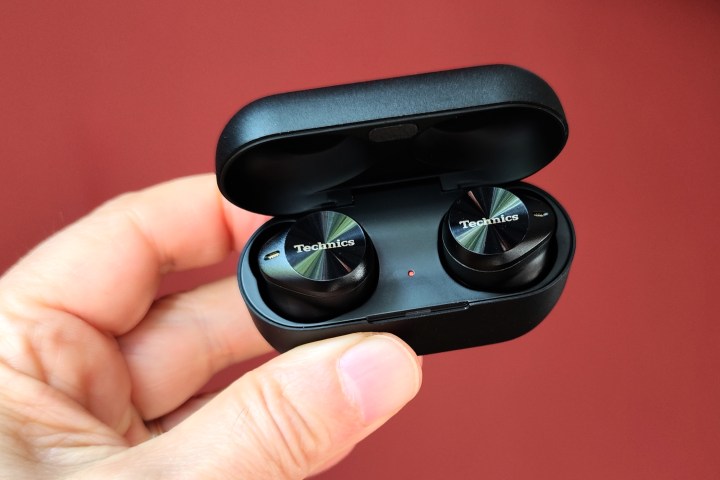
Technics has used a new 10mm driver on these earbuds and while it’s hard to say if this is the ingredient that makes the biggest difference, I don’t think there’s any doubt about the result: sound quality on the AZ80 is very good. Out of the box, the tuning on these earbuds is a satisfying balance of frequencies, with a decidedly warm overall tone. I’ve noticed that some recent premium wireless earbuds like the Bose QuietComfort II and the Bowers & Wilkins Pi7 S2 tend to come from the factory with an emphasis on the highs. This definitely adds energy to the sound and helps to generate that initial wow factor when you start listening. The AZ80 take a more laid-back approach. Without sacrificing any detail, the upper mids and highs are a little more reserved, which lets you relax into your music. This creates something of a contradiction when it comes to the soundstage — making it both more open and yet less precise.
On some tracks, this really works. I’ve been spending time with Drastic Symphonies, some of Def Leppard’s greatest hits rearranged and re-recorded with the help of the Royal Philharmonic Orchestra, and a track like Gods of War, with its powerful, movie soundtrack-like vibe, benefits greatly from the openness.
If it doesn’t suit your listening preferences, the Audio Connect app’s EQ presets and manual options will let you tweak the tuning considerably: dynamic mode, in particular, will likely be a favorite for folks who want to get closer to the popular Harman Curve.
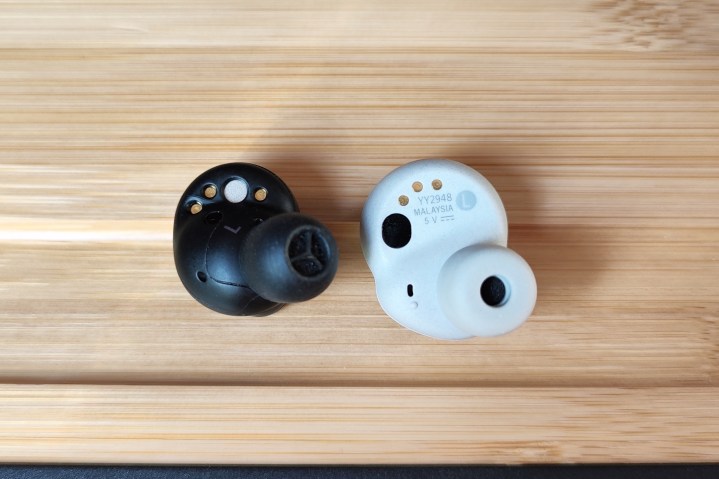
Listening at lower volumes can be a bit underwhelming. These buds come into their own at about the 60% level and things start to get thrilling at 70%. I don’t recommend heading north of 80%, but if you do, you won’t need to worry about distortion — it’s very tight all the way to the top.
I think the AZ80 sound better than the AirPods Pro 2 and Sennheiser Momentum True Wireless 3, but putting them back to back with the Sony WF-1000XM4 revealed differences that you may want to note. Overall, the XM4 delivered more power at the same volume level. For instance, 60% on the XM4 sounded closer to 70% on the AZ80. The XM4 offers better separation of frequencies. It’s not night and day by any means, but I suspect that most listeners will hear more detail via the XM4 than with the AZ80. Finally, though they come very close on bass response, if you want deeply resonant bass, the Sonys are still a better choice.
The AZ80 support Sony’s LDAC Bluetooth codec for hi-res audio (Android only). With the right source material — preferably lossless, hi-res from Apple Music, Amazon Music, or Qobuz — a short distance from your phone to your earbuds (less than four feet is ideal), and a quiet environment, you’ll be able to hear subtle improvements in detail when using LDAC versus the normal AAC codec. Keep in mind, to get the most out of LDAC you’ll need to turn off Bluetooth Multipoint, but it’s an easy change to make in the app.
If call quality is a top priority, the AZ80 beats virtually all of the premium earbuds with the possible exception of the AirPods Pro 2. They handily kept most competing noises at bay and my voice remained clear, even with a light breeze. Indoors, call quality was even better, as you’d expect.
As I mentioned earlier, Attention mode is your best bet while on calls for hearing your own voice clearly.
Battery life on the AZ80 is on the higher side of average, assuming you stick with AAC, and keep ANC turned off: Technics claims you’ll get about 7.5 hours per charge in the earbuds, with a total of 25 hours when you include the case. That drops a tiny bit to 7/24 with ANC on.
Switching to the LDAC codec will diminish this performance a lot — LDAC is an especially power-hungry way of doing wireless hi-res audio. It drops to 5/17 (ANC off) and then down to 4.5/16 with ANC on. These numbers also assume a volume level of 50% so be prepared to get a little less if you’re listening louder (which I recommend you do).
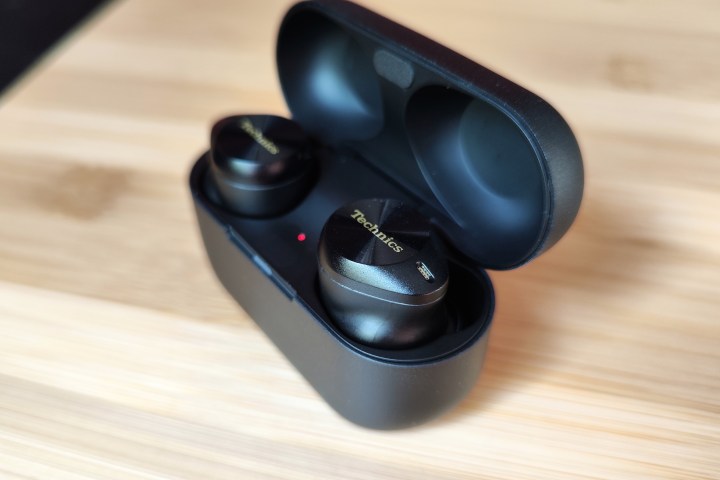
The AZ80’s touch controls work very well and are complemented by two features: wear sensors, and control customization within the Audio Connect app. The wear sensors can trigger auto-pause when you remove the buds from your ears and it’s up to you if you want playback to automatically resume when you replace them. Changing the controls is easy and very flexible. Unlike Sony’s XM4, which require you to select from control “groups,” the AZ80 give you four gestures per earbud, each of which can be associated with any function the buds support — including access to your phone’s assistant or Amazon Alexa (which you can also summon hands-free using the Alexa wake-word).
At $300, Technics might have priced the EAH-AZ80 a little on the high side, especially when you consider the superb Sony WF-1000XM4 come in at $280 (and can frequently be found on sale for much less). Still, the AZ80 are smaller and more comfortable, offer better call quality, and have the convenience of three-way Bluetooth Multipoint. If those strike you as good reasons to spend a little more, I’m definitely not going to argue; the AZ80 are an excellent set of wireless earbuds.
Editors’ Recommendations

